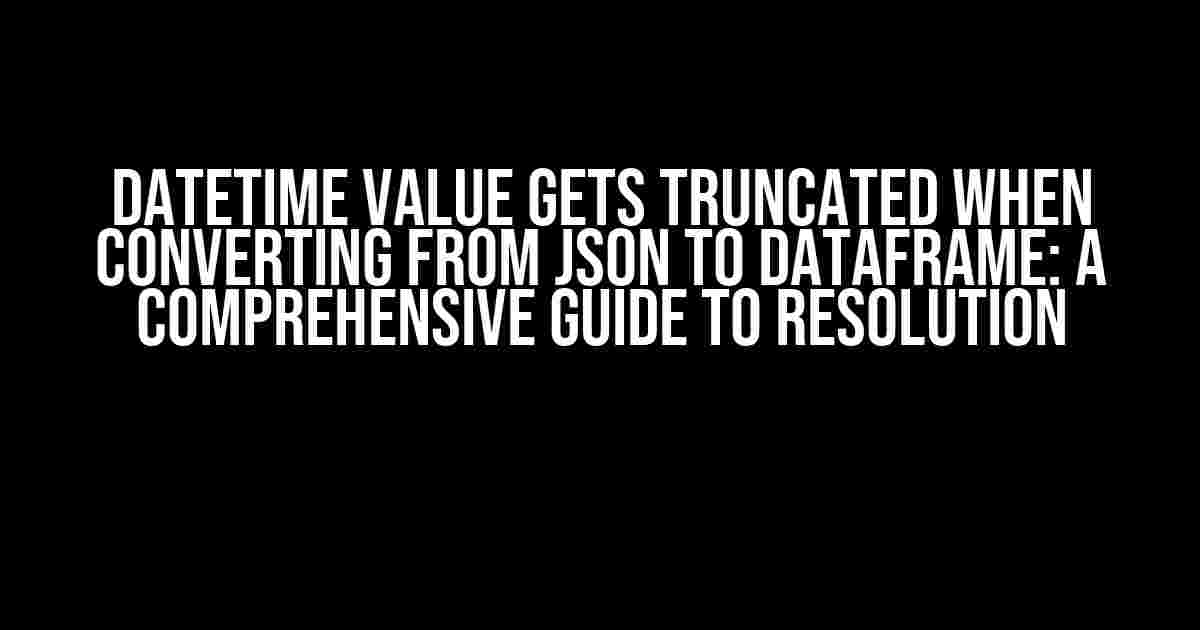Are you struggling with datetime values getting truncated when converting JSON data to a Pandas dataframe? You’re not alone! This frustrating issue can occur when working with datetime columns in JSON files, leading to inaccurate data analysis and modeling. In this article, we’ll delve into the reasons behind this problem and provide a step-by-step guide to fix it.
Understanding the Issue: Datetime Value Truncation
When converting a JSON file to a Pandas dataframe using the read_json() function, datetime values might get truncated, resulting in losing valuable information. This truncation occurs because JSON doesn’t have a built-in datetime data type, and Python’s JSON parser interprets datetime strings as regular strings.
For example, consider a JSON file containing the following data:
[
{"id": 1, "datetime": "2022-01-01 12:00:00"},
{"id": 2, "datetime": "2022-01-02 13:00:00"},
{"id": 3, "datetime": "2022-01-03 14:00:00"}
]
When you convert this JSON data to a Pandas dataframe, the datetime column might appear truncated:
import pandas as pd
df = pd.read_json('data.json')
print(df)
id datetime 0 1 2022-01-01 12:00:00 1 2 2022-01-02 13:00:0 2 3 2022-01-03 14:00:0
Notice how the datetime values are truncated, losing the last few characters. This can lead to inaccurate data analysis and modeling.
Reasons Behind Datetime Value Truncation
There are two primary reasons behind datetime value truncation when converting JSON to a Pandas dataframe:
- JSON parser limitations: Python’s JSON parser,
json, doesn’t recognize datetime strings as a specific data type. Instead, it treats them as regular strings, which can lead to truncation. - Pandas dataframe conversion: When Pandas converts the JSON data to a dataframe, it uses the
objectdata type for datetime columns by default. This can cause truncation, especially if the datetime strings are not in a standardized format.
Resolving Datetime Value Truncation
To resolve datetime value truncation, you can use the following strategies:
Method 1: Use the date_unit Parameter
The read_json() function provides a date_unit parameter, which can be set to 'ms' to specify the unit of the datetime values. This ensures that the datetime values are parsed correctly:
df = pd.read_json('data.json', date_unit='ms')
This method works well when the datetime values are in a standardized format, such as ISO 8601. However, if your datetime strings are not in a consistent format, you may need to use a more robust approach.
Method 2: Convert Datetime Columns Manually
You can convert the datetime columns manually using the pd.to_datetime() function. This approach provides more control over the conversion process:
import pandas as pd
df = pd.read_json('data.json')
df['datetime'] = pd.to_datetime(df['datetime'])
This method allows you to specify the format of the datetime strings using the format parameter:
df['datetime'] = pd.to_datetime(df['datetime'], format='%Y-%m-%d %H:%M:%S')
By specifying the correct format, you can ensure that the datetime values are parsed accurately.
Method 3: Use the json_normalize() Function
The json_normalize() function from the pandas.io.json module provides more control over the JSON parsing process. You can use this function to specify the datetime columns and their formats:
from pandas.io.json import json_normalize
data = [{'id': 1, 'datetime': '2022-01-01 12:00:00'},
{'id': 2, 'datetime': '2022-01-02 13:00:00'},
{'id': 3, 'datetime': '2022-01-03 14:00:00'}]
df = json_normalize(data, sep='_')
df['datetime'] = pd.to_datetime(df['datetime'], format='%Y-%m-%d %H:%M:%S')
This method is useful when working with complex JSON structures or when you need fine-grained control over the parsing process.
Best Practices for Working with Datetime Values in JSON
To avoid datetime value truncation and ensure accurate data analysis and modeling, follow these best practices:
- Use standardized datetime formats: Use consistent and standardized datetime formats, such as ISO 8601, to ensure that datetime values are parsed correctly.
- Specify datetime formats explicitly: When converting JSON data to a Pandas dataframe, specify the datetime formats explicitly using the
formatparameter. - Use robust parsing methods: Use robust parsing methods, such as the
pd.to_datetime()function, to handle datetime values with varying formats. - Validate datetime values: Validate datetime values to ensure they are accurate and consistent. You can use the
pd.to_datetime()function with theerrors='coerce'parameter to detect invalid datetime values.
By following these best practices and using the strategies outlined in this article, you can ensure that your datetime values are parsed accurately and consistently when converting JSON data to a Pandas dataframe.
Conclusion
Datetime value truncation when converting JSON to a Pandas dataframe can be a frustrating issue, but it’s easily resolvable using the strategies outlined in this article. By understanding the reasons behind this issue and following best practices, you can ensure that your datetime values are parsed accurately and consistently. Whether you’re working with small or large datasets, it’s essential to handle datetime values with care to ensure accurate data analysis and modeling.
| Method | Description |
|---|---|
Using date_unit parameter |
Sets the unit of the datetime values to milliseconds. |
| Converting datetime columns manually | Uses the pd.to_datetime() function to convert datetime columns. |
Using json_normalize() function |
Provides more control over the JSON parsing process. |
Remember, accurate and consistent datetime values are crucial for data analysis and modeling. By following the strategies outlined in this article, you can ensure that your datetime values are parsed correctly and consistently.
Additional Resources
For further learning and reference, check out the following resources:
By applying the knowledge and strategies outlined in this article, you’ll be well-equipped to handle datetime value truncation when converting JSON to a Pandas dataframe.
Here is the HTML code with 5 questions and answers about “Datetime value gets truncated when converting from json to dataframe”:
Frequently Asked Question
Get answers to your most pressing questions about Datetime value getting truncated when converting from JSON to DataFrame.
Why does my datetime value get truncated when converting from JSON to DataFrame?
This is because JSON does not have a native datetime type, so it gets converted to a string when parsing the JSON data. When you convert this string to a datetime column in the DataFrame, it may get truncated depending on the format. To avoid this, you can specify the datetime format when parsing the JSON data or when converting the column to datetime type in the DataFrame.
How do I preserve the datetime format when converting from JSON to DataFrame?
You can use the `pd.io.json.json_normalize()` function to parse the JSON data and preserve the datetime format. Alternatively, you can use the `date_format` parameter when converting the column to datetime type in the DataFrame, for example: `df[‘column_name’] = pd.to_datetime(df[‘column_name’], format=’%Y-%m-%d %H:%M:%S’).
Can I convert a JSON string to a datetime object directly in Python?
Yes, you can use the `datetime` module in Python to convert a JSON string to a datetime object. For example: `from datetime import datetime; datetime.strptime(‘2022-01-01 12:00:00’, ‘%Y-%m-%d %H:%M:%S’)`. This will convert the JSON string to a datetime object with the specified format.
Why do I get a ValueError when converting a datetime string to a datetime object?
This is because the datetime string is not in the correct format. Make sure the format matches the format specified in the `strptime` function. For example, if your datetime string is ‘2022-01-01 12:00:00’, the format should be ‘%Y-%m-%d %H:%M:%S’. If the format is incorrect, a ValueError will be raised.
How do I handle missing or null datetime values when converting from JSON to DataFrame?
You can use the `errors` parameter when converting the column to datetime type in the DataFrame to handle missing or null datetime values. For example: `df[‘column_name’] = pd.to_datetime(df[‘column_name’], errors=’coerce’)`. This will convert any missing or null values to NaT (Not a Time) in the datetime column.


